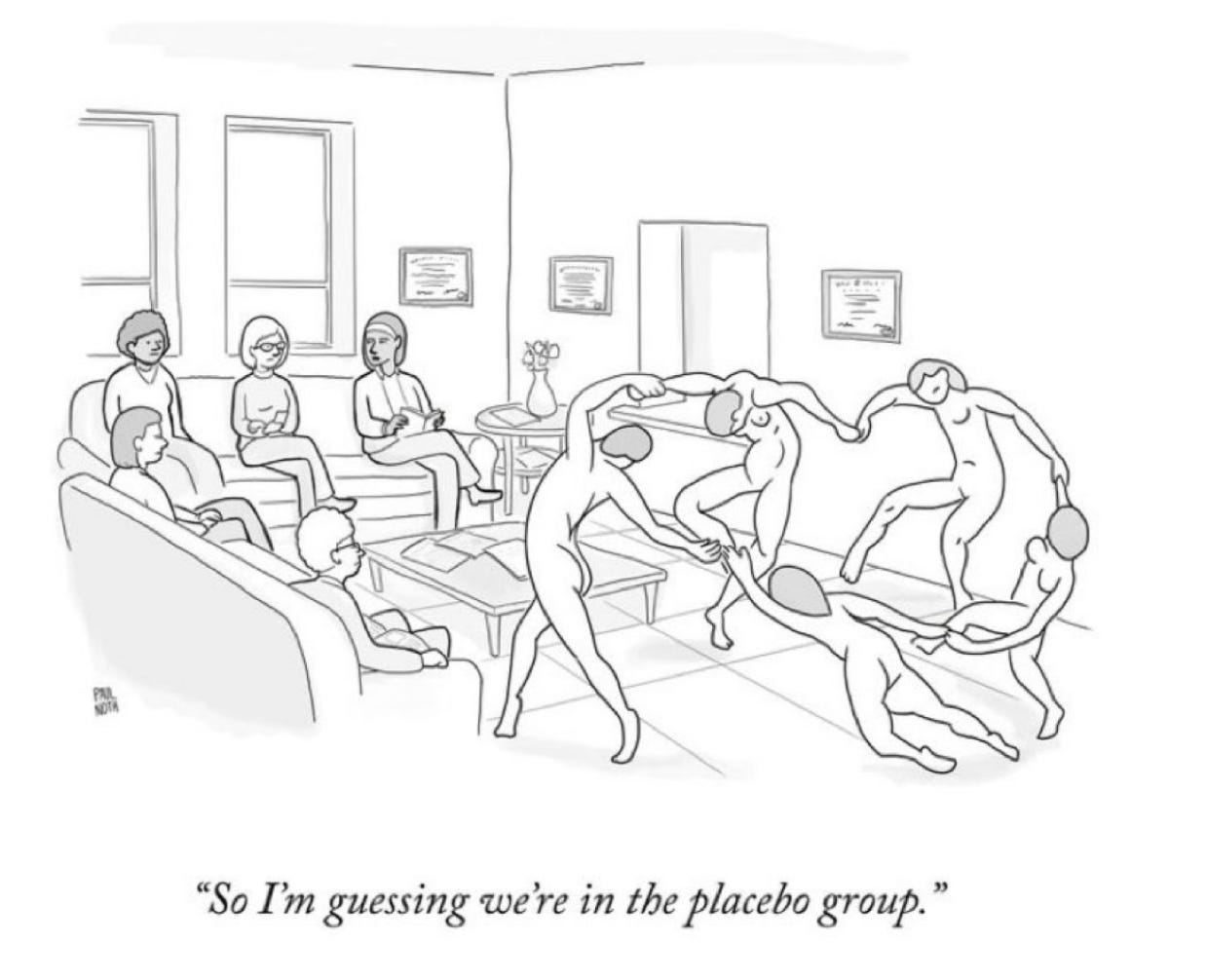Hey friends,
It’s newsletter #50!!!
Have you read all of them?
If you’re just joining us, a few of the most popular Nina’s Notes of the last year were:
#37: 😮💨 Humans Are Chronic Mouth Breathers
💬 In this note:
💊The Power of Belief: When Sugar Pills Work Wonders
📚 Invisible Women
⚡️Super Moon
💊The Power of Belief: When Sugar Pills Work Wonders

The placebo effect is the mysterious power our minds have to make us feel better, even when we are taking just a sugar pill instead of real medicine.
Several studies have shown that this effect is a legitimate biopsychosocial phenomenon that is an integral part of the overall treatment response.
Research has found that the placebo effects can be as strong as the effect of the actual medicine in randomized controlled trials (RCTs).
When scientists want to test a new drug, they use what’s called a double-blind RCT.
In this trial design, two groups of people are tested, one gets the real medicine and the other gets a fake one (the placebo).
The twist? Neither the people taking the medicine nor the ones giving it know which is which. This helps to make sure that the results are trustworthy and not biased.
Even with this careful setup, it’s tough to uphold the true integrity of the double blind information and sometimes the secret of who got the drug and who didn’t gets out.
This is especially true in psychedelic studies.
The RCT design assumes that the effects of a drug being studied can be isolated, added, and/or subtracted from the “nonspecific effect” of context and person, studied by the placebo.
However, despite the goal of blinding, it is rare for trials to uphold blinding integrity and incorporate this information into the results.
While these trials are great for assessing the added benefit of novel drugs, they don’t always show us the full power of the placebo effect.
It’s a hidden superpower we are still trying to understand.
The History of Placebo in the Clinic
In 1772, a Scottish doctor named William Cullen reported prescribing a remedy to a patient despite believing it to be inefficacious. He explains that sometimes “it is necessary to give a medicine and [this is] what I call a placebo.”
The role of the placebo was to give patient’s hope and to make doctors’ work easier in difficult or desperate cases.
Placebos were considered as inert substances with “fake” psychological but benign effects. They were believed that they cannot cause harm, but may relieve symptoms.
It was only in the 1950s, with the rise of informed consent and autonomy as pillars of medical ethics, that the practice of deceiving patients “for their own good” was put into question.Today, the deceptive use of placebos is seen as a relic of an older era.
However, despite this change in mindset, 46-95% of doctors prescribed placebos in 2018.
Placebos in Research
In the 20th century, placebos began to be used in research to assess the added benefit of drugs and to discard harmful or ineffective treatments. By 1946 the comparative experimental framework was advocated for in clinical trials.
The Placebo Effect
In 1955 Dr. Henry Beecher wrote an article called The Powerful Placebo, which catapulted the ideas on the placebo into popularity and changed the way researchers thought about the placebo effect.
He found that about one-third of participants in clinical trials were experiencing relief from their symptoms.
Before, placebos were often just given to patients to make them feel better, and many brushed them off as just “all in the mind.”
However, in research, the placebo effect led to discerning between useful and non-useful treatments. This insight from Dr. Beecher helped scientists figure out which treatments really worked and which didn’t.
In 1962, the RCT design comparing the effects of treatment and placebo groups became the gold standard for pharmaceutical manufacturers to demonstrate efficacy and safety to regulators.
Placebo in Psychedelic Studies
Using a placebo in psychedelic studies is a challenge. It is very obvious to the recipient who receives a placebo versus a psychedelic.

And placebo effects have been shown to be enhanced by the setting of the psychedelic study.
A recent study looked at placebo psychedelics alone in the context of a psychedelic party. Researchers threw a party for 33 students. They gave them placebo, telling them it was similar to psilocybin, the hallucinogenic molecule found in psychedelic mushrooms.
The party had music, colorful lights, mesmerizing paintings and visual projections.
Some of the people at the party were in on the secret. They were there to act like they were feeling the effects of “the drug” and to make the study participants believe that there was no placebo control group.
The results indicated that context and expectations can promote psychedelic-like effects.
The party vibes and expectations made the participants feel like they had a psychedelic trip, even without taking any real drugs.
The individual variability within the placebo effects was considerable.
Some felt nothing, while others felt like they’d taken a strong dose of psilocybin.
In psychedelic studies, it is much more difficult to use the traditional framework for assessing the effectiveness of a drug against a placebo.
The environment and mindset, often referred to as “set and setting” can play a huge role in the effects of the drug.
The effects can be synergetic. The drug influences the “set and setting” and the “set and setting” influences the drug effect.
Since the party setting can itself be a game changer on the effects of the drug, these elements should be seen as factors central to psychedelic science, and cannot be disregarded as noise.
How to control for the placebo effect in psychedelic studies?
A group of drug experts including Prof. David Nutt, Robin Carhartt-Harris, Balázs Szigeti and David Erritzoe, recently wrote a preprint (an article shared prior to peer-review) on the fallibility of placebo control.
When people think they are getting the true drug but aren’t, their expectations can mess with the results of the trial.
They call this combination of weak blinding and positive treatment expectancy, activated expectancy bias (AEB).
The effect of AEB is an uneven distribution of expectancy effects between placebo and drug due to patients recognizing what they received in psychedelic randomized controlled trials.
To counteract the bias, the researchers proposed the Correct Guess Rate Curve (CGRC), a computational model and novel analytical tool that can estimate what the results of the trial would look like if everyone was completely in the dark about whether they got the real drug or a placebo.
Results from the CGRC suggest that placebo-controlled studies are more fallible than conventionally assumed leading to researchers thinking a drug works when in fact it does not.
The CGRC can help fix this bias, and it is cost effective and less resource intensive.
Most solutions to improve blinding are difficult to implement and resource intensive. Thanks to these experts, we now have a useful tool to make drug research more reliable.
With the resurgence of psychedelic research in randomized controlled trials, it has highlighted the antiquated system we have used for the last century to evaluate drug effectiveness.
The idea of “set and setting” should not stand alone for use in psychedelic research. Perhaps more treatments could benefit from improved set and setting.
Furthermore, in psychedelic studies the psychedelics are given in a treatment regime that involves psychotherapy, resulting in the name psychedelic-assisted therapy.
The idea is not to give the treatment to the patient and send them on their way. The psychotherapist will prepare the patient for treatment, be with them during treatment, and help them integrate in follow-up sessions.
It would be interesting if more treatments used the structure as described above. Most treatments are given after a very brief talk with a doctor, and then usually results in a “give me a call if you don’t improve.”
What if the doctor said, "call me if you improve or if you don’t.” Perhaps it could strengthen the doctor-patient relationship. Even “the placebo effect” could be integrated into a person’s recovery.
The holistic approach of psychedelic-assisted therapy, where the journey is as important as the treatment itself, offers a promising blueprint for future medical practices.
By fostering deeper doctor-patient relationships and harnessing the power of the placebo effect, we could revolutionize the way we heal and care.
📚 Book of the Week
Invisible Women, Data Bias in a World Designed for Men by Caroline Criado Perez
5 / 5 Stars
Everyone read this.
While scientists are working hard to improve the data bias, there are still huge disparities in data amongst any minority group.
Most drug studies are done on caucasians even though the largest populations in the world are in Asia. We extrapolate our findings to include these groups, while instead we should be using more comprehensive, diverse groups of participants.
Nearly every chapter sent me into a rage about the state of data bias. I had to take breaks away from the book to calm down.
I likely annoyed my friends while I was reading this book. In every conversation I’d bring up some fact like, “Did you know they didn’t make female crash dummies until the 1990s! The 1990s! They just treated women as smaller men. We are not smaller men!”
No matter your gender. It’s something we need to talk about.
⚡️ Check This Out
Mohamed Elshahed—Anadolu Agency/Getty Images
Did you see the supermoon last week?
Here are some amazing pictures across the globe.





I read Invisible Women a couple of years ago and was also horrified. I wish everyone would read it :( It's wild to think, especially in the pharma industry, how little diversity there is when testing is done. I have PCOS and recently discovered that most Mediterranean women have it. Of course, it's not exclusive to us. Still, it's much more common, so when I went to the private Gyno in Turkey, she was a lot more relaxed about it versus my Gyno as a Teenager who prescribed me a contraceptive pill that was blocked a couple of years later as it was too dangerous to be taken.